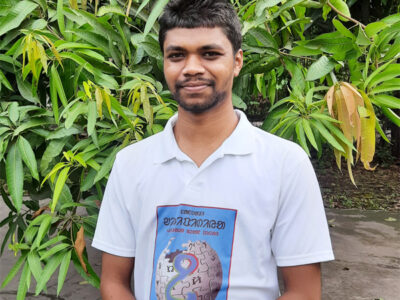
Photo provided by Jeannet Stephen and used with permission.
Editor's note: From April 14-20, 2021, Jeannet Stephen will be hosting the @AsiaLangsOnline rotating Twitter account, which explores how technology can be used to revitalize Asian languages. Read more about the campaign here.
When Jeannet Stephen was working on her graduate school thesis, she observed code-switching (the practise of alternating between two or more languages or varieties of language in conversation) within an indigenous Kadazan family in Malaysia. As a Kadazan herself, she immediately saw her own experience reflected in this “passive bilingualism,” in that she could understand the Tangaa’ or coastal Kadazan language, but she could not speak it, as was the same with many local people. While it frustrated her that she could not speak her language, it also motivated her to continue to learn and support other language communities in the state of Sabah in Borneo, Malaysia.
Together with mentors and supportive friends, the motivation led to the setup of the Research Unit for Languages and Linguistics of Sabah at Universiti Malaysia Sabah. The unit then joined the Borneo Research Institute for Indigenous Studies (BorIIS) as the Languages and Linguistics Cluster. The Institute is exploring different strategies to revitalize local languages. It recently held a webinar with Wikimedia Indonesia and the Indonesian Language Planning Agency on the topic of “Sustaining Indigenous Languages through the use of Wikimedia projects”. It has also contributed resources for the Endangered Languages Project’s COVID-19 Information on Indigenous, Endangered, and Under-Resourced Languages, with the creation of posters in Kadazandusun, Kadazan, Dusun, Rungus, Kimaragang, Tobilung, Murut, and Bajau languages.
Rising Voices (RV): What is the current status of your language offline, as well as online?
Jeannet Stephen (JS): Offline, if you go by the Expanded Graded Intergenerational Disruption Scale (EGIDS), Kadazan is considered as 6b – Threatened. Ethnologue reports the size and vitality of Kadazan as ‘Endangered’ with that red color, which means it is no longer the norm for children to learn and use this language.
It is present online in one form or another. There are several Facebook groups that use a ‘Let’s Learn’ concept, where the members support each other by conversing in the language. Most recently, there has been active input online from the local Sabah Cultural Board on their social media platform. That is a positive development, especially when they involve the ethnic bodies or associations and the youths. There used to be an online version of a local newspaper that has indigenous language news columns, but sadly no more. The indigenous language page on another local daily also finally stopped last year.
Material-wise, in my opinion, Kadazan is quite [far] ahead compared to the other indigenous languages, in that it already has several printed dictionaries. There is also a dedicated radio channel in the language.
RV: What do you think are the biggest challenges facing your language community when it comes to digital communications or creating digital content in their mother language?
JS: In my opinion, the biggest challenge would be perhaps in getting sustained interest [from the audience] to view digital content in indigenous languages, and for digital content creators to be motivated to continue creating digital content in the indigenous language.
Digital content creators are many, but a glance on YouTube shows sporadic uploads. I believe this is also because digital content needs audience for feedback and to motivate the content creators. Is there interest from the indigenous communities to hear or see their indigenous languages online? This is perhaps a question that the indigenous communities need to ask themselves because language champions cannot work in a vacuum, we need the indigenous communities too to be interested to champion their languages, to want to sustain their languages, and together, the collaboration will then be more successful, offline or online.
That is [when] we are talking about local indigenous viewers. On another hand, digital content need not be limited to just local viewers/audience from your neighborhood. The netizens of the world are [a] potential audience. If you make your content interesting and you have subtitles in English (or whatever language you aim to have viewers from), netizens from all over the world will be able to engage with your material.
Having said [this], digital content creators need good internet access, and especially in the rural areas where families are still using the indigenous language in their home as their first language (L1). So these challenges can be in the form of sustained interest, translation capacities, as well as internet access.
RV: In your opinion, what are some of the steps that could be taken to encourage increased use of the language on the internet?
JS: 1) Better internet access in all areas. 2) Training for content creators from the rural areas – perhaps provide them with internet data credit (and digital equipment, if they don’t have any e.g. smart phones). 3) Training for content creators to include translation of their contents into the national language or English. This is what digital content creators in Indonesia (the nearest example) do when they have content in their dialects. They include subtitles in Bahasa Indonesia. The topic could be any topic under the sun, but viewers need not be limited to just those who [can] speak [the language]. Perhaps collaboration can be made between digital content creators (those who are tech savvy) and those in their network who are fluent speakers to provide the translations. 4) Ethnic associations could pool their resources together to produce online newspapers in their indigenous languages.
RV: What is your primary motivation for working to see your language and culture available on the internet?
JS: My primary motivation is to know that my identity as an indigenous person remains relevant even as time moves on. In the future, I hope to see the indigenous languages and culture move away from the labels of ‘threatened’ or ‘endangered’. Some may ask why, it is inevitable, they are not part of this modern era and we need to move on to catch up with the rest of the world. Precisely so, by using technology we can bring the indigenous languages to catch up to the times. The indigenous languages don’t have to stay in dusty cabinets. We can use technology to have our languages and cultures available online – for our young and old generations and for others to learn it as well. It has been done before by other communities, albeit with hard work and commitment.



